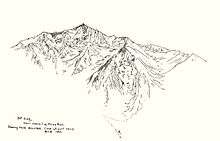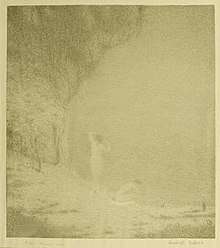Bolton Brown
Bolton Coit Brown (November 27, 1864 – September 15, 1936)[1] was an American painter, lithographer, and mountaineer. He was one of the original founders of the Byrdcliffe Colony in Woodstock, NY, part of what is now referred to as the Woodstock Art Colony.

Before Woodstock: Stanford and the Sierras
Brown was born and raised in Dresden, in upstate New York. After receiving his Masters in Painting from Syracuse University,[2]:16–17 he moved to California in 1891 to create the Art Department at Stanford University. Brown headed the department for almost ten years, but was dismissed in a dispute over his use of nude models in the classroom.[2]:44–47 Although his own art was heavily influenced by the Tonalist aesthetic, his methods of teaching, which contrasted sharply with the traditional approached at the nearby School of Design in San Francisco, stressed the Impressionist credo of a rapid execution of “natural subjects” in the wilderness.[3] Students often visited his studio-home for discussions on various environmental and political causes. In 1898 Brown designed the studio rooms in Stanford’s new Art Building, which included such “radical” innovations as “one continuous belt of glass” eight feet high and muted terra cotta and gray tones on the walls.[4] The walls were covered with reproductions and original works “by the avant-garde artists of Paris.”[3] One of his more successful students, the painter Jennie V. Cannon, published reviews of his exhibitions and several short biographies which described a quiet, serious and, compassionate teacher with steadfast principles.[5]
Brown was an accomplished mountain climber and benefited from Stanford’s proximity to the Sierra Nevada range, mostly famously explored by Sierra Club founder John Muir (1838–1914). Brown was the first to record climbing a group of peaks in the Sierras with, in two instances, his intrepid wife Lucy; his most challenging first ascent was of Mount Clarence King (also known as Mount King[6]) in August 1896.[7][8] According to the Climber’s Guide to the High Sierra, Brown’s ascent of Mount King was the first time advanced aid-climbing techniques were used in North America.[9]:247 Nearby Mount Bolton Brown (13,538 ft) is named after him; Brown also named several peaks in the area of Mount King.[8]

Byrdcliffe
Brown’s skills as an artist and outdoorsman brought him to the attention of Ralph Radcliffe Whitehead (1854–1929), an aristocratic utopian who developed the concept, and supplied the capital, for the Byrdcliffe Colony. Byrdcliffe was an artists’ colony based on ideals and models provided by John Ruskin (1819–1900) and the English Arts and Crafts movement. Brown convinced Whitehead that Woodstock, NY, in the heart of the Catskill Mountains, was where Byrdcliffe should be, although Whitehead had planned on a location further south.[10] Along with fellow artistic spirit Hervey White, also hired by Whitehead, Brown developed and managed the grounds of Byrdcliffe from 1902–1903. But Brown and White were both, ultimately, unable to sustain working relationships with Whitehead. White left of his own accord; Brown, meanwhile, was fired.[11]
Painter-printmaker
Bolton Brown went on to create experimental landscape paintings, migrating between Woodstock and New York City and working within the style that came to be known as Tonalism. He exhibited one painting at the legendary 1913 Armory Show in New York but, despite skill and dedication, never succeeded as a painter. In 1915, he turned to lithography, a print-making technique that would ultimately occupy his time and intellect to an almost obsessive degree. Brown earned his greatest fame printing lithographs for well-known Woodstock artist George Bellows,[12] whose premature death in 1925 was both a professional and emotional blow to Brown. In addition to printing for Bellows, Rockwell Kent, John Sloan, George William Eggers and others, Brown created over 400 lithographs of his own,[13] with a focus on nature and female nudes; lithographs such as Moonlight Bathers (1915), Cloudy Dawn, (1916) and Sifting Shadows (1916) represent Brown's ability to translate Tonalism from painting into a print medium.[13]
Death
Brown died in 1936 in Woodstock, alone and impoverished but by no means unaccomplished. Thinking and working ceaselessly until the end, he left behind an enormous output of lithographs and writings, including books and articles on painting and lithography and 12 volumes of journals documenting his experiments in print-making.[14]
References
- ↑ Wisbey, Herbert A., Jr. (November 1995). "Bolton Brown: Dresden's Other Famous Son". Crooked Lake Review.
- 1 2 Adams, Clinton (1993). Crayonstone: The Life and Work of Bolton Brown. Albuquerque: University of New Mexico Press.
- 1 2 Edwards, Robert W. (2012). Jennie V. Cannon: The Untold History of the Carmel and Berkeley Art Colonies, Vol. 1. Oakland, Calif.: East Bay Heritage Project. pp. 11, 39, 41–42, 64–65, 158, 166, 688. ISBN 9781467545679. An online facsimile of the entire text of Vol. 1 is posted on the Traditional Fine Arts Organization website (http://www.tfaoi.com/aa/10aa/10aa557.htm)%5B%5D.
- ↑ The Daily Palo Alto (Stanford University’s student newspaper): 23 September 1898, p.1; 5 October 1898, p.5.
- ↑ Berkeley Daily Gazette (Berkeley, CA): 26 February 1921, p.6; 12 March 1921, p.6; 26 March 1921, p.6; 26 July 1924, p.6.
- ↑ "Mount Clarence King". Geographic Names Information System. United States Geological Survey. Retrieved 2008-12-29.
- ↑ Brown, Bolton (1897). "Wanderings in the High Sierra, Between Mt. King and Mt. Williamson, Part 2". Sierra Club Bulletin. 2 (2): 95–96.
- 1 2 Cheryl Angelina Koehler (March 2007). Touring the Sierra Nevada. University of Nevada Press. p. 198. ISBN 978-0-87417-700-8. Retrieved 19 December 2011.
- ↑ Roper, Steve (1976). The Climber’s Guide to the High Sierra. San Francisco: Sierra Club Books.
- ↑ Bolton Brown, “Early Days at Woodstock,” published posthumously in 1937, reprinted in Bolton Coit Brown: A Retrospective, exh. cat. (New Paltz: Samuel Dorsky Museum of Art, SUNY, 2003), p. 73
- ↑ Tanyol, Derin (Summer 2012). "'Stone, The Most Perfect of Surfaces': Bolton Brown in the Sierra and Woodstock". Nineteenth-Century Art Worldwide. 11 (2).
- ↑ "George Wesley Bellows Original Lithographs & Drawings". www.georgebellows.com. 2011. Retrieved 2011-12-24.
- 1 2 Netsky, Ronald (2003). "Bolton Brown: Artist, Teacher, Printer". Bolton Coit Brown: A Retrospective. New Paltz: Samuel Dorsky Museum of Art, SUNY. p. 30.
- ↑ John Taylor Arms Papers, Bryn Mawr College Library Special Collections.
External links
- Bolton Brown at The British Museum
- Biography of Bolton Brown, Fletcher Gallery
- Byrdcliffe Art Colony History
- Exploration of the Sierra Nevada
- Sierra Club Bulletins 1893–1896